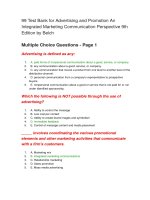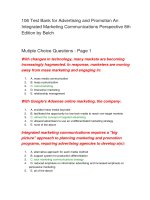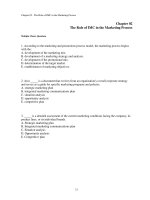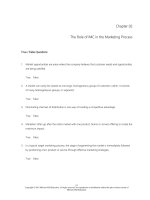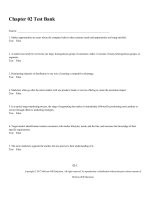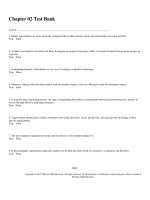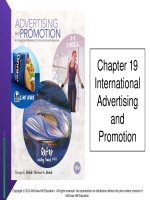Lecture Advertising and promotion: An integrated marketing communications perspective (10/e): Chapter 16 - George E. Belch, Michael A. Belch
Bạn đang xem bản rút gọn của tài liệu. Xem và tải ngay bản đầy đủ của tài liệu tại đây (953.21 KB, 18 trang )
Chapter 16
Sales
Promotion
Copyright © 2014 McGraw-Hill Education. All rights reserved. No reproduction or distribution without the prior written consent of
McGraw-Hill Education.
Sales Promotion
“A direct inducement that offers an extra value or
“A direct inducement that offers an extra value or
incentive for the product to the sales force,
incentive for the product to the sales force,
distributors, or the ultimate consumer with the
distributors, or the ultimate consumer with the
primary objective of creating an immediate sale.”
primary objective of creating an immediate sale.”
An extra
An extra
incentive to buy
incentive to buy
A tool to
A tool to
speed up sales
speed up sales
Targeted to
Targeted to
different parties
different parties
Types of Sales Promotion Activities
Copyright © 2014 McGraw-Hill Education. All rights reserved. No reproduction or distribution without the prior written consent
of McGraw-Hill Education.
3
Reasons for the Increase in Sales
Promotion
Growing power of retailers and declining brand loyalty
Increased promotional sensitivity
Brand proliferation
Fragmentation of the consumer market
Short-term focus and increased accountability
Competition and clutter
Growth of digital marketing
Copyright © 2014 McGraw-Hill Education. All rights reserved. No reproduction or distribution without the prior written consent
of McGraw-Hill Education.
4
Consumer FranchiseBuilding versus
NonfranchiseBuilding Promotions
Consumer franchise-building
Nonfranchise-building (non-FB)
(CFB) promotions
promotions
• Communicate distinctive brand
• Accelerate the purchase decision
attributes and contribute to the
process and generate an immediate
development and reinforcement of
increase in sales
brand identity
• Build long-term brand preference
• Help achieve full-price purchases that
are not dependent on promotional
• Do not contribute to the building of
brand identity and image
• Merely borrow customers from other
brands
offers
• Capable of converting consumers to
loyal customers
Copyright © 2014 McGraw-Hill Education. All rights reserved. No reproduction or distribution without the prior written consent
of McGraw-Hill Education.
5
Sampling
Sampling Works
Best When
Products are of
relatively low unit
value, so samples
don’t cost much
Products are divisible
and can be broken
into small sizes that
reflect the products
features and benefits
Purchase cycle is
relatively short so
the consumer can
soon purchase
again
Sampling Methods
Door-to-door sampling
Sampling through the mail
In-store sampling
On-package sampling
Event sampling
Sampling through magazines and newspapers
Sample request forms
Sampling through the internet and social media
Copyright © 2014 McGraw-Hill Education. All rights reserved. No reproduction or distribution without the prior written consent
of McGraw-Hill Education.
7
Advantages and Limitations of
Couponing
Advantages
• Appeals to price-sensitive customers
• Does not require retailers’ cooperation
• Reduces consumer’s perceived risk
associated with trial of a new brand
• Encourages repeat purchase
• Helps coax users to trade up to more
expensive brands
Limitations
• Estimating how many consumers will
use a coupon and when is difficult
• Less effective for inducing initial
product trial in a short period
• Consumers already using the brand
cannot be prevented from using the
coupons
• Have low redemption rates and high
costs
• Could result in misredemptions
Copyright © 2014 McGraw-Hill Education. All rights reserved. No reproduction or distribution without the prior written consent
of McGraw-Hill Education.
8
Types of Premium
Free premiums: Small gifts or merchandise:
Included in the product package
Sent to consumers who mail in a request along with
a proof of purchase
Selfliquidating premiums: Require the consumer
to pay:
Some or all of the cost of the premium
Handling and mailing costs
Copyright © 2014 McGraw-Hill Education. All rights reserved. No reproduction or distribution without the prior written consent
of McGraw-Hill Education.
9
Contests and Sweepstakes
Sweepstakes
Promotion where winners are
determined purely by chance
Cannot require proof of purchase
as a condition for entry
Winners chosen by random selection from pool
of entries or generation of a number to match
those held by game entrants
Consumers compete for prizes or money on the
basis of skills or ability
Contest
Winners determined by judging entries
or ascertaining which entry is closest
to predetermined criteria
Advantages & Limitations of Refunds
and Rebates
Copyright © 2014 McGraw-Hill Education. All rights reserved. No reproduction or distribution without the prior written consent
of McGraw-Hill Education.
11
Advantages and Limitations of Bonus
Packs
Advantages
• Direct way to provide extra value
• Have a strong impact on the purchase decision at the time of
purchase
• Effective defensive maneuver against competitor’s promotion
• May result in larger purchase orders and favorable display space
in stores
Limitations
• Require additional shelf space without providing extra profit
margins for retailers
• Appeal primarily only to current users and promotion-sensitive
consumers
Copyright © 2014 McGraw-Hill Education. All rights reserved. No reproduction or distribution without the prior written consent
of McGraw-Hill Education.
12
Advantages and Limitations of Priceoff
Deals
Advantages
• Ensure discounts reach the consumers
• Present a readily apparent value to shoppers
• Encourage consumers to purchase larger
quantities
Limitations
• Can create pricing and inventory problems
• Appeal primarily to regular users and not new
users
• Must adhere to regulations set by the Federal
Copyright © 2014 McGraw-Hill Education. All rights reserved. No reproduction or distribution without the prior written consent
Trade Commission
of McGraw-Hill Education.
13
Event Marketing versus Event
sponsorship
Event marketing
• Company or brand is linked to
Event sponsorship
• Company develops
an event, or a themed activity
sponsorship relations with an
is developed to:
event and provides financial
• Create experiences for
support in return for:
consumers
• Promote a product or
service
• Right to display a brand
name, logo, or advertising
message
• Being identified as a
supporter of the event
Copyright © 2014 McGraw-Hill Education. All rights reserved. No reproduction or distribution without the prior written consent
of McGraw-Hill Education.
14
Figure 16.5 ConsumerOriented Sales Promotion
Tools for Various Marketing Objectives
Copyright © 2014 McGraw-Hill Education. All rights reserved. No reproduction or distribution without the prior written consent
of McGraw-Hill Education.
15
Types of Trade Oriented Promotions
Contests and incentives
Types
Coop Advertising
Trade allowances
POP displays
Buying
Sales training
Promotional
Trade shows
Slotting
Types of Cooperative Advertising
Horizontal cooperative advertising
• Sponsored by a group of retailers providing products or
services to the market
Ingredient-sponsored cooperative advertising
• Supported by raw materials manufacturers
• Establishes end products that include the company’s
materials and/or ingredients
Vertical cooperative advertising
• Manufacturer pays for a portion of the advertising a retailer
runs to promote the manufacturer’s product
Copyright © 2014 McGraw-Hill Education. All rights reserved. No reproduction or distribution without the prior written consent
of McGraw-Hill Education.
17
Figure 16.8 The Sales Promotion Trap
Copyright © 2014 McGraw-Hill Education. All rights reserved. No reproduction or distribution without the prior written consent
of McGraw-Hill Education.
18

